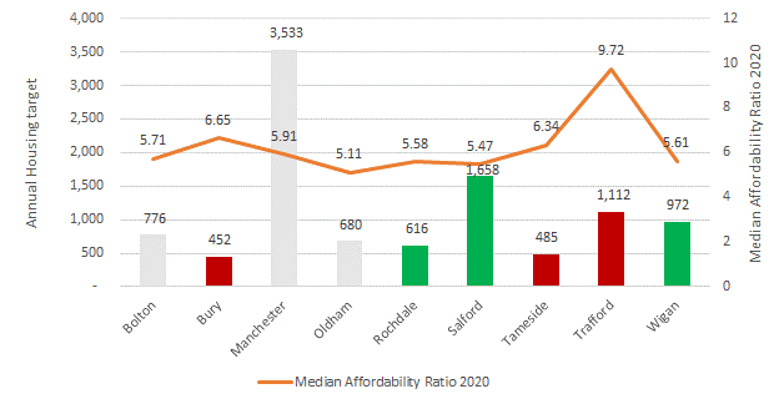The consultation on the Joint Development Plan for 9 of the Greater Manchester authorities concluded on Sunday 3rd October. It is expected that the Plan will be submitted to the Secretary of State for Examination later this year and the Combined Authority is anticipating adoption of the Plan by 2023.
In the context of these aspirational timescales the Joint Plan has been subject to wholesale criticism by various action groups particularly those opposed to the quantum of Green Belt to be release as well as from the house building industry. In the housebuilders opinion, the Plan is deficient in many areas and will not meet its objective of delivering 164,880 homes by the end of the Plan period (2037).
The Places for Everyone (PfE) Plan sets an ambition of meeting housing needs for the 9 districts including increasing the delivery of affordable homes to provide 50,000 affordable homes (30% of the total) and providing a diverse mix of housing. Despite Objective 1 of this Plan relating to increasing the delivery of homes, it is important to frame this in the context that each version of the Joint Plan has reduced the proposed annual housing requirement and the number of units to be delivered on sites released from the Green Belt (Table 1). Since the 2016 iteration of the Plan, the number of homes proposed to be delivered on Green Belt sites has reduced from 63,616 to just 20,472.
Table 1 GMSF/PfE - Total Housing Requirement and Green Belt Allocations
The PfE seeks to reduce its housing requirement further from previous iterations of the Joint Plan going against national planning policy which seeks to boost the supply of housing. Not only that, but the spatial strategy for housing which sits behind Plan seeks to direct growth to where potential supply may be available in the future rather than being based on evidence relating to the homes are actually needed in each district. There are also many questions in relation to some of the sites which have been included in the claimed supply within the PfE. Notably that a number of the sites have significant constraints associated with them and have marginal viability.
The PfE seeks to increase the housing requirement in certain districts whilst simultaneously reducing the numbers in other districts for no rational reason aside from where supply may be available and to reduce potential Green Belt release (Table 2). This is being done on the proviso that the 9 Districts form one Housing Market Area and a family in one part of the city region would choose to move to another to secure a home (e.g. from Altrincham (Trafford) to Royton (Oldham). However, this approach is wholly flawed and unrealistic.
Table 2 PfE Requirement v Local Housing Need
The approach being advocated for has largely ignored significant issues across the 9 districts, such as affordability and the need to deliver affordable homes. There is no logical rationale in the Plan’s evidence base for significantly reducing the minimum number of homes which should be delivered in Bury, Tameside and Trafford. Coupled with that, an objective of the Plan seeks to direct growth to the north of the city region (i.e. including Bury) and to reduce inequalities and improve prosperity (i.e. Tameside) but the housing policies do not respond to this objective.
Finally, the 3 Districts which are proposing to provide for less than their minimum local housing need are also the 3 Districts with the worst affordability ratios (Bury, Tameside and Trafford). Despite the issues in the housing market in these districts, all three have sought to shirk their responsibilities to deliver the minimum housing requirement derived using the Government’s standard method. It is also worth noting that Trafford has one of the worst affordability ratios in the north of England and far in excess of the national average (7.15), which includes the London Boroughs (ONS Statistics). Since the joint Greater Manchester Plan commenced preparation in 2014, Trafford’s affordability ratio has worsened from 7.53 to 9.46. Despite this, Trafford is seeking to offload 255 homes annually to other districts on the basis that Trafford residents would be willing to move to areas such as Middleton (Rochdale) or Standish (Wigan) for example.
Figure 1 Affordability Ratio and Provision of Homes

There are significant housing issues being currently experienced across the 9 Districts and no District is immune. Despite this, in an attempt to persuade an Inspector at Examination that the Plan can demonstrate a 5-year supply of housing land, it has sought to unjustifiably and arbitrarily reduce the housing requirement in the first 4 years of the Plan. Again, this further exacerbates the issues with housing supply particularly the District’s ability to deliver more affordable homes to meet the needs for people in need now. There is no rationale or logical reason behind artificially reducing the requirement in the first 4 years of the Plan and PfE is effectively seeking to validate the flaws of a number of authorities in Greater Manchester for failing to plan positively over the past decade and ensure sufficient and continuous housing land supply is available. Of particular note is Bury that is proposing to reduce its housing requirement by 66% in the first 4 years of the Plan and Tameside that is seeking to reduce its annual requirement in the first 4 years by 54%.
Bury has not adopted a Plan since 1997 and has continually and unsuccessfully not been able to demonstrate a 5-year supply of housing land. Similar issues are being experienced in Tameside who also last adopted a Plan in 2004.
Table 3 PfE Annual Requirement (2021/25) v Local Housing Need
Aside from the issues with the distribution of the housing requirement across the 9 Districts, the size and type of homes which are proposed to be delivered has been determined by the make up of the supply rather than an assessment of what future residents will need in the future. The supply set out in the PfE indicates that 59% of the homes delivered will comprise 1 and 2 bedroomed apartments most likely delivered in high density schemes. This flies in the face of what the demographics for the 9 Districts indicate will be needed. Table 4 sets out the results of analysis undertaken by Lichfields and indicates that there will be a need for 60% 3- and 4-bedroom houses which will not be delivered based on the supply of sites identified in the PfE.
Of particular note is Trafford, where the identified supply is anticipated to deliver just 35% of the units as 3- & 4-bedroom homes whereas the actual need in the district is for 69% to comprise larger homes. Similar issues are anticipated in Salford where the supply will deliver just 19% larger homes whilst the need is for 61% of the requirement to form larger homes. There is a complete mismatch between the supply set out in the PfE and what the needs over the plan period in the district are. This issue has been largely ignored by the Plan and no mechanism are being proposed to address the significant issues.
Table 4 Housing Mix Analysis

The PfE rightly recognises the significant issues associated with the delivery of affordable homes in the 9 Districts. The evidence underpinning the Plan indicates that there is a need for 72,000 affordable homes to be delivered across Greater Manchester but the PfE only seeks to deliver 50,000 affordable homes over the Plan period, effectively ignoring a significant part of the overall need. Notwithstanding, it is recognised that delivering 50,000 units over the Plan period would represent a stepped change in average delivery rates. However, the Plan does not set out an effective strategy for how the 50,000 affordable homes will be delivered aside from making some vague statements about needing to secure additional government funding to boost the supply. It is also worth noting that the Viability Assessment which underpins the PfE indicates that only 10,200 affordable homes can viably be delivered over the Plan period. Despite this, the PfE disappointingly does very little to positively address the issue. The identification of additional Green Belt sites in sustainable locations where viability may be less marginal would significantly boost the supply of affordable units.
There are particular affordable housing need issues in a number of authorities including Tameside, Oldham, Bury and Bolton. Tameside’s annual affordable housing need is in excess of their housing requirement set out in the PfE and as set out earlier, Tameside is an authority seeking to deliver less than its minimum housing requirement derived from the Government’s standard method. No regard has been paid by Tameside on the effect on the delivery of much needed affordable housing as a result of pursuing a lower overall housing requirement.
Oldham and Bury have significant issues too with affordable housing need and the authorities’ needs are over 80% and 90% respectively of the overall housing requirement being pursued. Despite the obvious affordable housing needs across the Districts, the spatial strategy for distributing housing requirement has ignored where the largest affordable housing need is and in fact has lowered the overall housing requirement in two authorities with the worst affordable housing need (Bury and Tameside) (Table 5).
Table 5 Housing Requirement v Annual Affordable Housing Need

There are a number of significant issues with the PfE as currently drafted which will need to be altered through the Examination process if the Plan is to be found sound. The Plan has been drafted with the mantra of reducing the Green Belt take at all costs in line with Mayor Burnham’s elections promises. Little regard is being paid to the type of housing which is required and where that housing is required to meet current and future needs. Coupled with that, the 9 Districts have significant issues associated with the delivery of affordable housing and a stepped change in delivery is required if the 50,000 target is to be achieved. Despite this, the Plan has not set a positive strategy for how the significant need for affordable homes will be addressed. Instead it is anticipating that existing brownfield land within the urban area will deliver significant proportions of affordable homes, a strategy that has been pursued in Greater Manchester for years but has failed to bear fruit.
The Plan is hugely reliant on brownfield sites coming forward proliferated by high density apartment type schemes. This will not deliver a sufficient number of homes or the right type of homes across the 9 districts. The Plan will need to identify additional Green Belt sites to deliver sustainable development. The additional sites need to be located in the areas of the 9 districts with the worst affordability issues and greatest affordable housing need. Not only that, the Plan needs to identify Green Belt releases of varying sizes, not just very large scale developments, so that they can come forward earlier in the Plan period and help to address the immediate housing issues being experienced in Greater Manchester.
Essentially, the Places for Everyone Plan is not for everyone. It is a failing plan that will affect the housing choices, opportunities and locations of future generations if the 9 Districts do not address some of the fundamental soundness issues that go to the heart of their own ambitions.









